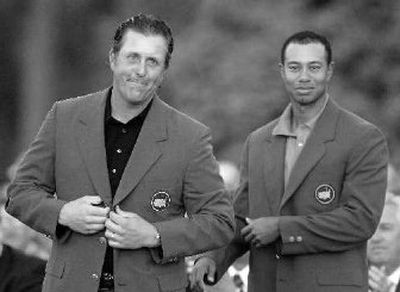Masterful style

AUGUSTA, Ga. – They were the two dominant figures in golf, one of them inspiring adulation from his adoring army of fans, the other evoking awe and appreciation for his sheer skill and display of power.
The green jacket fit both well.
Arnold Palmer and Jack Nicklaus defined the Masters for the better part of a decade, trading green jackets during a five-year stretch in the 1960s, although rarely going head to head on the back nine of Augusta National.
Now, only the names seem to have changed.
Tiger Woods and Phil Mickelson have won five of the last six Masters, and there is little evidence to suggest the 71st Masters will be any different when it starts Thursday.
“We both feel comfortable on the golf course,” Woods said. “We both have decent short games, and that golf course is one of the very few golf courses where we can utilize our imagination and creativity. I think once you understand how to play it, and you can build your misses into some short-game situations, you start seeing the same guys up there at the top of the board.”
But not since 2001 have Woods and Mickelson put their names atop the leaderboard at the same Masters.
Mickelson won his first Masters – and first major – in 2004 after a spirited duel with Ernie Els on the back nine, while Woods had long cleaned out his locker and wound up 11 shots behind. Woods outlasted Chris DiMarco in a playoff in 2005, while Mickelson was nine shots behind and spent his final round discussing metal spikes with Vijay Singh.
Mickelson was threatened only briefly on the back nine last year by Fred Couples to win by two shots. Woods hung around, only to miss several putts inside 12 feet that kept him from any kind of charge. He finished in a tie for third, three shots behind.
“Phil now has got more majors,” Nicklaus said earlier this year. “He’s figured out how to win. He’s closing the gap.”
Palmer wasn’t sure what to make of the Woods-Mickelson rivalry, but he remembered plenty from his days of swapping green jackets with Nicklaus – Palmer won in 1962 and 1964, Nicklaus in 1963, 1965 and 1966.
“I think it helps the game to have that kind of a rivalry,” Palmer said. “The more we can talk about Phil and his golf and the challenge to Tiger, I think that’s good. They have different approaches. Tiger has his approach and obviously, it’s quite good. Phil has his approach and he’s been pretty successful and just recently started winning majors.
“The competition is what it’s all about,” Palmer added, with one caveat. “I don’t see Tiger backing off for a while.”
Palmer and Nicklaus had company back then from Gary Player, who rounded out the “Big Three.” Player, who will tie Palmer this year by competing in his 50th consecutive Masters, won his first green jacket in 1961, and he was considered part of that group because of his 1962 victory in the PGA Championship and completing the career Grand Slam in 1965, one year before Nicklaus joined the club.
So who plays the role of Player in this era?
“Probably Vijay,” Woods said. “Obviously, he’s been very successful there. He’s always in contention there.”
Singh, 44, won in 2000 and has finished no worse than a tie for eighth his last five trips to Augusta National. He joins Woods as the only two-time winners on the PGA Tour this year.
Anymore, the “Big Three” is just a number.
It was the “Big Four” when Ernie Els came close to winning all four majors in 2004, and it became the “Big Five” when two-time U.S. Open champion Retief Goosen finally got his due. Jim Furyk is now No. 2 in the world ranking, although he has not seriously contended this year.